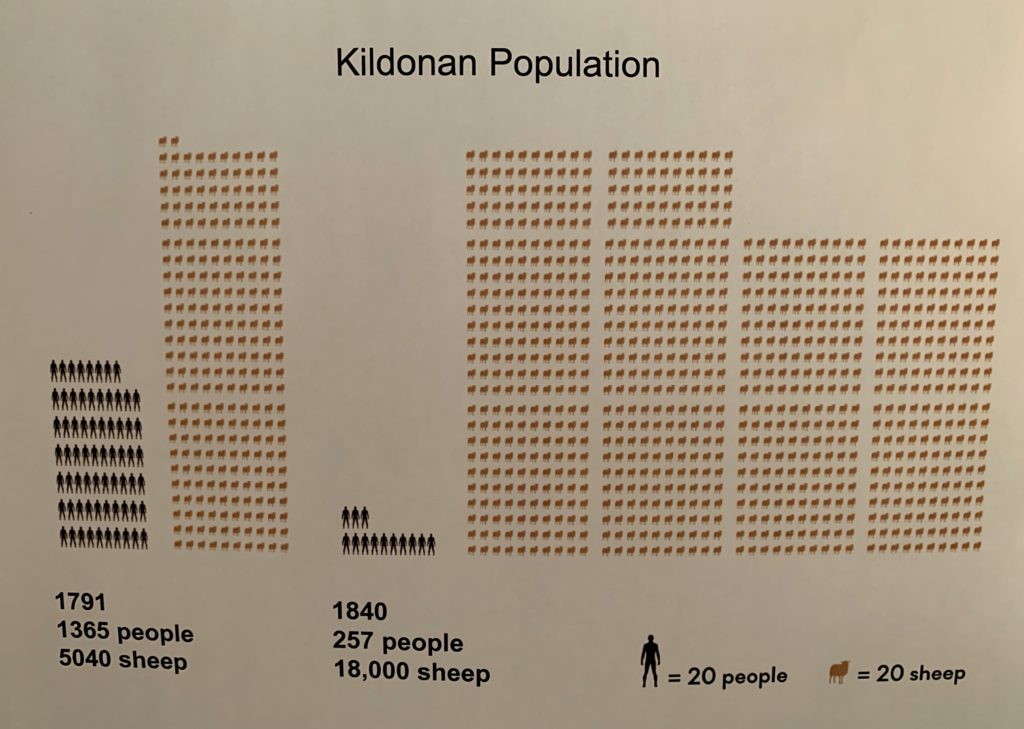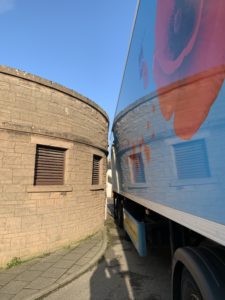Highland Clearances
 Two centuries ago the Duke and Duchess of Sutherland decided they could profit more by installing large-scale sheep farms on their vast holdings just north of Dornoch. But to do so, the small farmers who had occupied the land for generations, earning insufficient revenues, would have to leave. Highland Clearances took place in the first half of the 19th century, when many Highlanders were either relocated to the coast to become fishermen or sent abroad. Some historians have tried to explain the Clearances as a necessary process of economic and agricultural change which was widespread across Europe in the late 18th and early 19th centuries. Other writers condemn the process, even describing it as an early version of “ethnic cleansing”.
Two centuries ago the Duke and Duchess of Sutherland decided they could profit more by installing large-scale sheep farms on their vast holdings just north of Dornoch. But to do so, the small farmers who had occupied the land for generations, earning insufficient revenues, would have to leave. Highland Clearances took place in the first half of the 19th century, when many Highlanders were either relocated to the coast to become fishermen or sent abroad. Some historians have tried to explain the Clearances as a necessary process of economic and agricultural change which was widespread across Europe in the late 18th and early 19th centuries. Other writers condemn the process, even describing it as an early version of “ethnic cleansing”.
This statue, The Emigrants, by Highlands sculptor Gerald Laing, was installed to honor those who left Scotland and settled abroad. I had visited this site before, on a windy, rainy day in August 2014. This time it affected me more profoundly, due to its strong resonance with current conflicts around the world. The inscription on the statue was written by Dennis MacLeod, a native of the area who emigrated to Canada and made a fortune in mining. It was he who underwrote most of the cost of the installation.
MacLeod helped set up a history faculty for the University of the Highlands and Islands in Dornoch, so that the story of the Clearances and their aftermath could be spread around the world. At the Dornoch Book Shop, I purchased The Highland Clearances Trail, by Rob Gibson, a nationalist Member of the Scottish Parliament and land reform campaigner, but it was one-sided and more for “ancestral tourists.”
At the Timespan Museum in Helmsdale I found a factual chart:

I wanted to learn more about historic events that may have involved my Kirkpatrick ancestors, whose ancestral home was in Scotland. At Dornoch’s HistoryLinks Museum, I found The Highland Clearances in Southeast Sutherland by Graham Park with sketches by Sally Orr (we met Sally and her husband, Peter Wild, at dinner last Saturday evening). This booklet provides a balanced view of the moral aspect of the Clearances:
The Clearances have acquired a reputation as one of the most shameful episodes in Scottish history and have caused a huge emotional reaction, especially among the descendants of the evictees. There has also been a tendency to romanticize the pre-Clearance state of the Highlands, which was probably never going to be capable of adequately supporting the then existing population. It is important therefore to keep a sense of proportion in evaluating its effects. Although causing huge suffering to large numbers of people, the effects are not comparable in scale to what happened in the aftermath of the Jacobite rising post-1746, or in the various genocidal wars of the 20th century. The Highland Clearances were no different in kind, but only in degree, from what was happening in the rest of industrializing Europe. What marks the Highland experience as different is the lack of alternative employment for surplus labour in nearby factories and the consequent requirement for such a large proportion of the displaced population to emigrate.
21st Century Clearances
 A shiny new 18-wheel lorry delivering supplies to the rear of Dornoch Co-op grocery store yesterday morning had a clearance of at most five inches. Dornoch’s year-around population is 2200. It absorbs many visitors in August. The streets are narrow; the buildings, old. There are no street lights, no Starbucks, no McDonald’s. We love it, but lorry drivers must be very skillful.
A shiny new 18-wheel lorry delivering supplies to the rear of Dornoch Co-op grocery store yesterday morning had a clearance of at most five inches. Dornoch’s year-around population is 2200. It absorbs many visitors in August. The streets are narrow; the buildings, old. There are no street lights, no Starbucks, no McDonald’s. We love it, but lorry drivers must be very skillful.
Leave a Reply